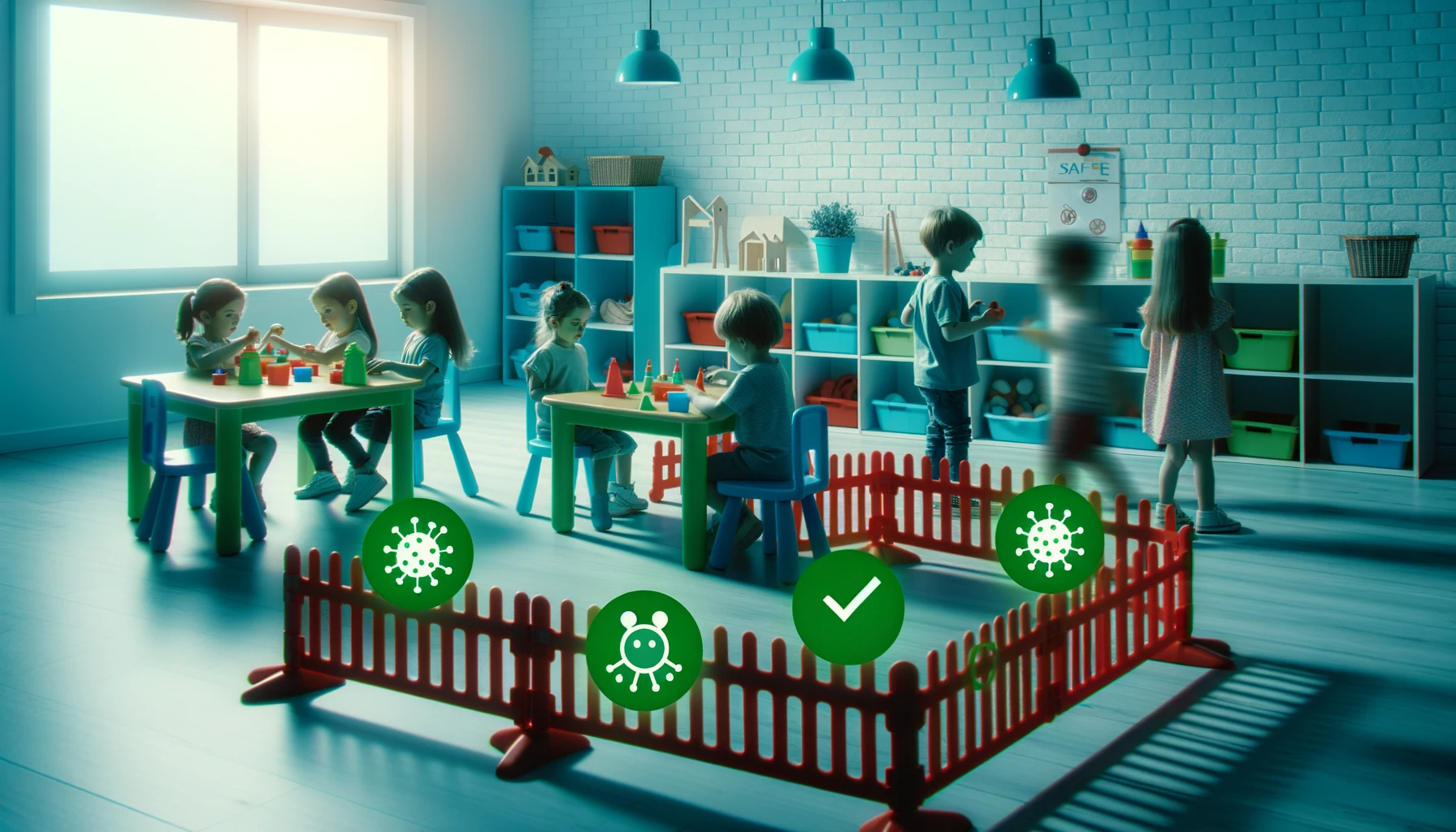Low Transmission in Child-Care Centers
In a prospective cohort study published in the Journal of American Medical Association, researchers from the United States (US) characterized the incidence of coronavirus disease 2019 (COVID-19) and transmission of the causative severe acute respiratory syndrome coronavirus 2 (SARS-CoV-2) in students who attended child-care centers (CCCs), as well as their child-care providers (CCPs) and household contacts. They found that the incidence and transmission of SARS-CoV-2 were low in CCCs. Additionally, as per the study, infected children in CCCs had a low probability of transmitting the infection within the CCC and to their households.
 Study: Incidence and Transmission of SARS-CoV-2 in US Child Care Centers After COVID-19 Vaccines. Image Credit: Created with the assistance of DALL·E 3
Study: Incidence and Transmission of SARS-CoV-2 in US Child Care Centers After COVID-19 Vaccines. Image Credit: Created with the assistance of DALL·E 3
Background and Gap in Existing Knowledge
Children in schools and CCCs are reported to transmit infectious diseases such as influenza to their contacts. As a greater number of children under five years of age were affected by COVID-19 in late 2021 and early 2022, the Centers for Disease Control and Prevention (CDC) recommended the closure of schools and CCCs, among other measures, to mitigate the potential spread of the disease. However, there is a dearth of evidence assessing the risk of transmission of SARS-CoV-2 via children in CCCs, especially in the US. Previous studies evaluated SARS-CoV-2 epidemiology in the pre-vaccine era in the low community transmission period. Addressing this gap, researchers conducted a year-long prospective surveillance study to investigate the incidence of COVID-19 and SARS-CoV-2 transmission among the children attending CCCs, their CCPs, and domestic contacts.
Study Methodology: How Researchers Addressed the Gap
From April 2021 to March 2022, the study included 1,154 children under five years of age from 11 CCCs in the US. The eligible children (students) attended the CCCs on two or all days of the week and had two or more household members. Out of these, the weekly active surveillance group included 83 students (mean age 3.86 years, 66% male), their 134 household contacts, and 21 CCPs. The CCPs included in the study worked at the CCC for two days a week and were in close contact with the children. The household members (adults as well as children) resided with the CCC students for at least two nights per week. Interestingly, 25% of the students were vaccinated against COVID-19 and influenza, and 71% were vaccinated against influenza.
CDC’s measures were followed by CCC directors for COVID-19 mitigation. CCC directors and COVID-19 surveyed the students, and CCPs positive cases were monitored, and their contacts were traced for potential transmission based on the case reports. The ethnicity and race of the participants were recorded along with their medical and COVID-19 history. Additionally, the participants maintained weekly diaries for COVID-19 symptoms, exposure to SARS-CoV-2, and new vaccinations.
Data Collection and Monitoring
While exposure was considered to be within six feet of an infected individual for a minimum of 15 minutes, the infectious period, index case, secondary case, incidence, secondary attack rate (SAR), and person-time were clearly defined at the start of the study.
The participants collected and submitted their own anterior nasal swabs every week, which were tested via reverse transcription polymerase chain reaction (RT-PCR) in the laboratory for COVID-19. Some participants voluntarily submitted additional blood samples to determine their anti-SARS-CoV-2 nucleocapsid antibody levels. The statistical analysis included the use of the Fisher exact test, chi-square test, Poisson regression clustering for incidence rate ratio estimation, as well as sensitivity analysis.
Key Findings: Low Incidence and Transmission Rates
In the self-reported and active surveillance groups combined, 13% of students and 22% of CCPs were found to be positive for COVID-19. The incidence rate ratio was found to be higher in surveillance students (1.9) as compared to the self-reported group. Asymptomatic infection was more common in students (34%) as compared to CCPs (8%). The SAR was found to be 2.7%–3%. It is important to note that the transmission within the CCC was not significantly different for a student index case versus that of a CCP.
Implications for Households
The cumulative household incidence was found to be 20.5%, and SARs were higher (50%–67%) for household contacts. Secondary infection rates in households were found to be low (17%). The seropositivity increased from 3% to 22% in the study duration, with 90% concordance with RT-PCR test results.
Strengths, Limitations, and Future Research
This study is the first published report to describe the epidemiology of COVID-19 in CCCs in the post-vaccine era. While the study's strengths are its prospective design and data quality, its limitations are the limited generalizability of the results and the high vaccination rate among participants.
What It Means for Child-Care Centers
In conclusion, the results suggest that CCCs showed lower transmission rates of SARS-CoV-2 in the study duration. Further, the transmission of SARS-CoV-2 within CCCs and household contacts was not significantly contributed to by the children attending the CCCs. The findings of this study emphasize the potentially insignificant role played by children in the spread of SARS-CoV-2 and have important implications for the potential revision of exclusion and testing recommendations in mild or asymptomatic cases in children for COVID-19 mitigation.